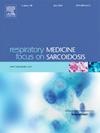慢性气流受限、呼吸道症状和生活质量在酒精使用类别中的相关性:一项基于人群的研究
IF 3.1
3区 医学
Q2 CARDIAC & CARDIOVASCULAR SYSTEMS
引用次数: 0
摘要
酒精使用对健康有重大影响,但酒精使用与呼吸道症状之间的关系仍相对缺乏研究。本研究探讨了危险酒精使用的患病率及其与呼吸困难、慢性咳嗽和健康相关生活质量(HRQoL)的关系,以及这些与慢性气道受限(CAL)的关系是否因酒精使用而异。方法瑞典心肺生物图像研究(SCAPIS)的横断面研究,包括25,424名年龄在50-64岁的患者。危险酒精使用被定义为酒精使用障碍识别测试(AUDIT)得分≥8。CAL定义为支气管扩张剂后FEV1/FVC比值<;0.7。通过问卷评估呼吸困难(mMRC评分≥2)、慢性咳嗽和HRQoL,采用SF-12短表测量。使用校正吸烟、BMI、年龄、性别、合并症和预测FEV1/FVC %的多变量回归模型分析相关性。在二次分析中,CAL和结果之间的关联通过酒精使用分层进行了检验。结果11%的分析样本和15%的CAL患者存在危险酒精使用。危险酒精使用与呼吸困难(比值比[OR] 1.37;[95%可信区间]1.09-1.70)和慢性咳嗽(比值比[OR] 1.46; 1.32-1.62)的几率增加相关,并与较低的身心HRQoL评分相关。与低水平饮酒者相比,CAL与危险饮酒者的症状相关性更强。结论危险饮酒与呼吸困难、慢性咳嗽和HRQoL降低有关。CAL与呼吸道症状之间的关联在危险饮酒的个体中更为明显,表明两者之间存在潜在的相互作用。本文章由计算机程序翻译,如有差异,请以英文原文为准。
Associations between chronic airflow limitation, respiratory symptoms, and quality of life across alcohol use categories: a population based study
Introduction
Alcohol use has significant health implications, yet the association between alcohol use and respiratory symptoms remains relatively understudied. This study examines the prevalence of hazardous alcohol use and its associations with breathlessness, chronic cough, and health-related quality of life (HRQoL) and whether these associations with chronic airway limitation (CAL) differ by alcohol use.
Methods
Cross-sectional study of the Swedish CArdioPulmonary bioImage Study (SCAPIS) comprising 25,424 aged 50–64. Hazardous alcohol use was defined as an Alcohol Use Disorders Identification Test (AUDIT) score ≥8. CAL was defined as a post-bronchodilator FEV1/FVC ratio <0.7. Breathlessness (mMRC rating ≥2), chronic cough, and HRQoL, measured using the Short Form 12 (SF-12) were assessed through questionnaires. Associations were analysed using multivariable regression models adjusted for smoking, BMI, age, sex, comorbidities, and predicted FEV1/FVC %. In secondary analyses, associations between CAL and outcomes were examined stratified by alcohol use.
Results
Hazardous alcohol use was present in 11 % of the analytic sample and in 15 % of those with CAL. Hazardous alcohol use was associated with increased odds of breathlessness (odds ratio [OR] 1.37; [95 % confidence interval] 1.09–1.70) and chronic cough (OR 1.46; 1.32–1.62), and with lower physical and mental HRQoL scores. CAL was more strongly associated with symptoms in participants with hazardous alcohol use than in lower-level users.
Conclusion
Hazardous alcohol use was linked to increased breathlessness, chronic cough, and lower HRQoL. Associations between CAL and respiratory symptoms were stronger among individuals with hazardous alcohol use, suggesting a potential interaction.
求助全文
通过发布文献求助,成功后即可免费获取论文全文。
去求助
来源期刊

Respiratory medicine
医学-呼吸系统
CiteScore
7.50
自引率
0.00%
发文量
199
审稿时长
38 days
期刊介绍:
Respiratory Medicine is an internationally-renowned journal devoted to the rapid publication of clinically-relevant respiratory medicine research. It combines cutting-edge original research with state-of-the-art reviews dealing with all aspects of respiratory diseases and therapeutic interventions. Topics include adult and paediatric medicine, epidemiology, immunology and cell biology, physiology, occupational disorders, and the role of allergens and pollutants.
Respiratory Medicine is increasingly the journal of choice for publication of phased trial work, commenting on effectiveness, dosage and methods of action.
 求助内容:
求助内容: 应助结果提醒方式:
应助结果提醒方式:


